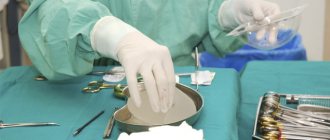Surgeries to change the shape and size of the mammary glands solve problems of an aesthetic nature and allow you to obtain ideal forms, but are associated with risks, like any surgical intervention. Pain after mammoplasty , burning, and swelling of the breast are common phenomena. For some women, symptoms gradually disappear and do not cause concern to the doctor; for others, they may lead to repeat surgery. How severe the consequences will be and how long they will last depends on many factors.
Why does swelling of the abdomen and chest appear?
The appearance of edema after mammoplasty is considered normal. This is explained by the fact that the body reacts in this way to the appearance of a foreign body. Swelling may be accompanied by discomfort and pain.
Given that each body reacts to surgery individually, the degree of swelling and the time it takes for it to subside varies.
In most cases, swelling is observed only in the chest area.
However, some patients experience abdominal swelling. This is also a normal reaction of the body. This indicates that the fluid does not accumulate in one place, but spreads throughout other tissues.
When does abdominal swelling go away? In about 3-4 weeks. There are factors that contribute to increased swelling in the chest area after surgery, these include :
- Thermal procedures. You can provoke swelling by visiting a bathhouse, sauna, solarium, or simply lying in a hot bath.
- Physical activity for the first 5-7 days after surgery. Considering that after mammoplasty it is not recommended to even raise your arms or make any other movements that affect the breast muscles, even slight physical activity can increase swelling.
- Intimate life. Sexual contacts should be excluded for the 30-day period after surgery, since during arousal, blood begins to actively circulate in the mammary glands.
- Increased body temperature. If fever appears after surgery, you must take the necessary measures as soon as possible to maintain body temperature at a normal level.
If after 3 days the fever does not subside, then this indicates the appearance of an inflammatory process in the body and immediate medical attention is required. - Incorrect body position during sleep. It is forbidden to sleep on your stomach and horizontally on your back. You can only sleep in a semi-sitting position.
- Compression. After surgery, you must wear compression garments without removing them at night for 30 days.
- Alcohol and blood thinning medications. In such a situation, there is a risk of bleeding.
In extremely rare cases, severe breast swelling after surgery occurs due to an unsuitable implant or a surgeon error during the operation.
Prevention of complications
If a woman decides to undergo major surgery to change the shape or size of her bust, she must prepare herself for numerous inconveniences and restrictions after mammoplasty. Strict rehabilitation conditions regarding taking medications, undergoing procedures and wearing compression stockings must be supplemented with important rules:
- sleep half-sitting;
- do not drive a car until the pain disappears;
- accept a load of no more than 3 kg;
- Raise your hands carefully and only as a last resort.
To eliminate as much as possible risks that do not depend on personal behavior, you must carefully select a surgeon and undergo a complete preliminary examination. Before the operation, it must be established that the implant material is completely compatible with natural tissues, there is no allergy to medications, and there are no diseases that may worsen after the operation or affect the healing of sutures.
If the doctor has identified at least one obstacle to mammoplasty, you need to hear it and choose another method of bust correction.
Photos before and after surgery
In the following photo you will see what the breasts look like before and after surgery.
Is it dangerous?
Despite the fact that swelling after mammoplasty is normal and does not pose any danger to health, there are situations when you should consult a doctor. If the following symptoms appear, breast swelling after surgery poses a threat to the patient’s health:
- change in skin color or appearance of a rash, blueness, redness;
- the appearance of local compactions;
- swelling continues to increase even after 7 days of rehabilitation;
- there is purulent discharge in the surgical sutures;
- body temperature rises;
- chills appear;
- a burning sensation is felt in the chest after a 7-day rehabilitation period.
If at least one of the above signs appears after mammoplasty, you should immediately seek help from a doctor.
Associated symptoms during the rehabilitation period
Injury to tissue in the bust area or the introduction of a foreign body causes consequences that manifest differently in each patient:
- Pain. You can't do without it. Immediately after the anesthesia wears off, my nipples and back hurt, and my glands swell. At first the syndrome increases, then subsides and disappears completely. To alleviate the condition, the woman is prescribed analgesics. How much breast pain after mammoplasty depends on various factors. Usually the symptom subsides after two weeks.
- Suppuration and burning. The condition indicates infection of the wound and penetration of bacteria through the injured tissue. A burning sensation in the chest is accompanied by high fever, back pain, and prolonged wound healing with the release of pus. To solve the problem, antibacterial therapy is prescribed, drainage and lavage are performed. If the burning sensation does not go away after the procedures, it may be necessary to remove the implant.
- Hematoma. Appears if bleeding begins from a damaged vessel or normal circulation is restored in the area where the lymph has clotted during surgery. Hematoma after mammoplasty can be recognized by a dark clot visible through the skin and a small thickening. It is removed with a scalpel or physiotherapeutic methods.
- Allergy. If the wrong material is chosen, the breast implant presses and burns. More often, the symptom manifests itself as a result of an omission during the preliminary examination, when the possible reaction of the body to a foreign body was not thoroughly studied. In this case, the endoprostheses will have to be removed. A manifestation of an allergy to drugs may be atypical swelling, which is accompanied by a change in skin color.
- Seroma. Fluid accumulates under the implant on one or both sides. Externally, seroma looks like uneven swelling and is detected only by ultrasound. The liquid is removed with a syringe, observing its exact location using ultrasound.
- Displacement of the endoprosthesis. It is impossible to predict how natural fabrics will behave. Excessive compaction may cause deformation or displacement of the implant. Surgeon errors and improper pocket formation are also possible.
- Loss of skin sensitivity. This is a normal phenomenon due to a violation of the integrity of the nerve endings, which should resolve within six months. In very rare cases, nipple sensitivity may be affected.
When does it go away, how many days does it last after breast augmentation?
Complications after surgery appear both in the early and late stages , i.e. in the first 14 days or after several months. Breast swelling appears early in the rehabilitation period. On days 3-4, swelling becomes more and more pronounced and spreads to the chest and even the abdomen.
When will the abdominal swelling go down after breast augmentation?
How quickly the swelling goes away depends on the complexity of the operation and the individual characteristics of the patient’s body. This condition can last up to 2-2.5 months.
You can learn more about what the consequences of mammoplasty can be, as well as see photos before and after breast augmentation surgery here.
Is it possible to remove it and how to remove it?
Breast swelling, although a normal phenomenon, is uncomfortable and not very pleasant. To relieve swelling, you can use the methods described below. It is recommended to first consult with the doctor who performed the operation.
Massage
Massaging to get rid of swelling after surgery is allowed only after 7 days of the rehabilitation period. Doing a massage yourself is strictly prohibited.
For the procedure, you should contact the clinic where the operation was performed. A light breast massage should only be performed by a specialist.
Cold compress
You can apply a cold compress to your chest yourself.
To do this, use either ready-made compresses or bandages, or those made at home. You will need to wrap several ice cubes in a small piece of cloth or gauze. If you don’t have ice cubes, you can use frozen foods, also wrapping them in a cloth first. You need to apply the compress to your chest as carefully as possible.
The duration of the procedure should not exceed 15 minutes. During the procedure, you need to remove the compress when the cold in the mammary glands becomes pronounced, and then apply it again.
The right underwear
It is prohibited to walk without compression underwear for the first month after surgery. Special underwear can be purchased at the clinic or provided after surgery.
A medical bra is made according to special requirements for the shape, size and fabric of the product. With the help of compression garments, the breasts are maintained in an ideal position, which prevents disruption of blood flow to the glands.
Read more about how to wear compression garments after mammoplasty, as well as the rules for caring for them, here.
Diet
As for your daily diet, you should avoid using salt and highly salted foods as much as possible , for example, dried fish. At the same time, it is necessary to comply with the drinking regime. This is necessary to flush salts from the body and prevent fluid retention in the tissues.
Diuretics
Diuretic drugs or herbal remedies will help quickly remove swelling. Drugs that have a diuretic effect remove excess fluid from the body.
A specific remedy should only be selected after consulting a doctor. It helps a lot in this situation:
- chamomile tea;
- lingonberry juice;
- cranberry juice.
How to fight if it doesn’t go away?
After breast surgery, you need to undergo regular examination by a doctor who will monitor the condition of the mammary glands. If the swelling does not go away, then you do not need to take any measures yourself. The doctor should do everything.
In cases where swelling does not subside for a long time, drainage is used. It is used to remove liquid accumulated in the area of the seams. The method is the most effective for quickly removing swelling.
Before you decide to undergo surgery to correct the shape of your breasts, we recommend that you read our articles about what reduction and augmentation mammoplasty are, how breast lifting and enlargement surgery, correction of nipples and areolas are performed, and how to understand that the plastic surgery was unsuccessful and what types of stitches are there and how long it takes to heal.
Important! Take care of your hand and avoid bruises, scratches, injuries and heavy loads
Heavy loads very often become a provoking factor for swelling of the arm after a mastectomy, as they contribute to the expansion and overload of both venous and lymphatic vessels. Moreover, it is important to avoid both lifting heavy objects and repeating monotonous hand movements. The most serious complication of lymphedema is erysipelas. This is an infection of the skin and subcutaneous tissue, causing fever, redness of the hand, poor health, provoking a sharp and persistent increase in swelling of the hand. Once occurring, this severe infection can recur again and again. Streptococci, which cause erysipelas, are ubiquitous, including in the air, and all people encounter them regularly. But the risk of developing an infection increases sharply with various skin injuries (bruises, injuries) and in the presence of lymphedema. It turns out that the swelling provokes erysipelas, and the infection, in turn, increases the swelling. Breaking this “vicious circle”, even with complex treatment, can be difficult even for experienced specialists.










